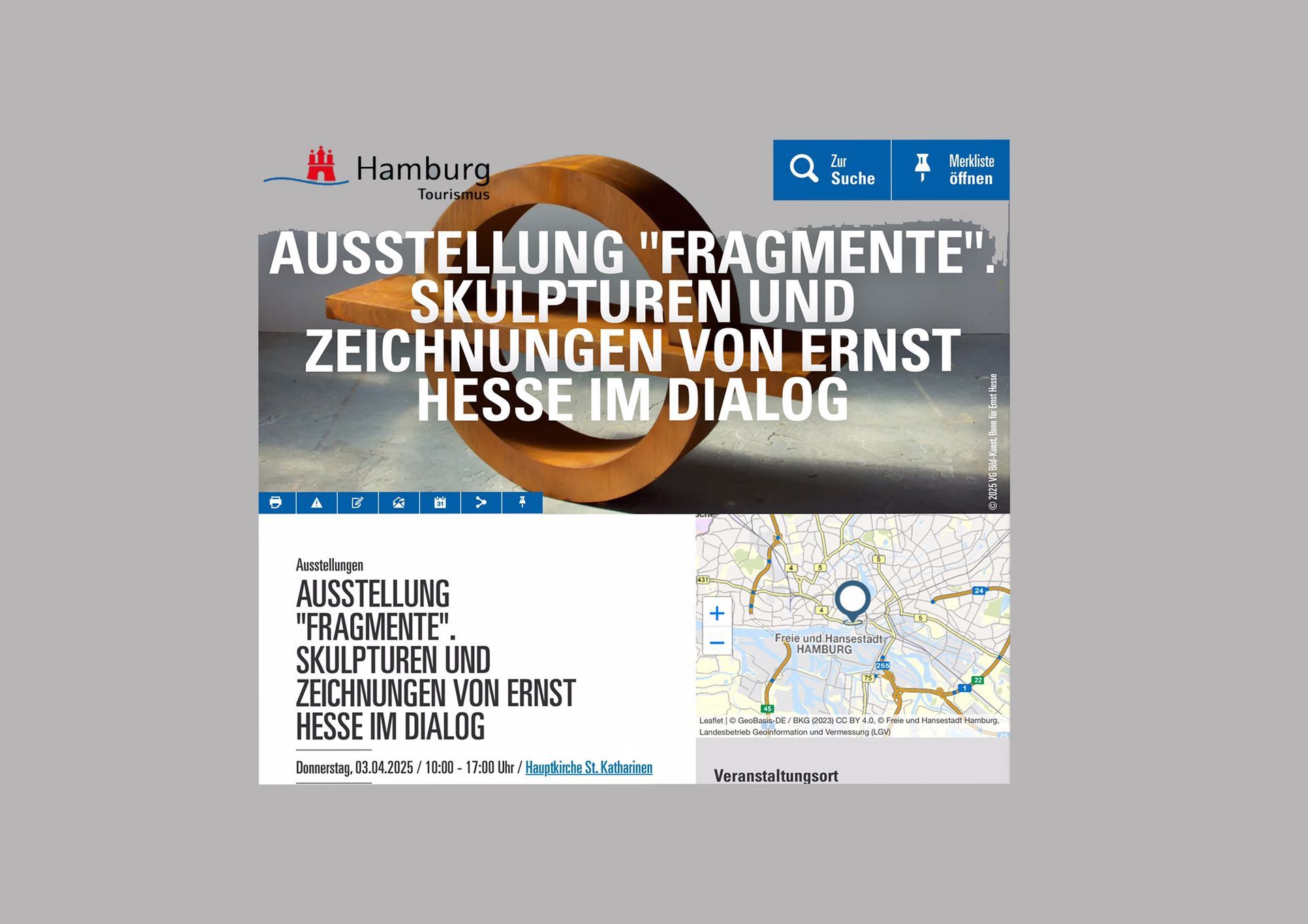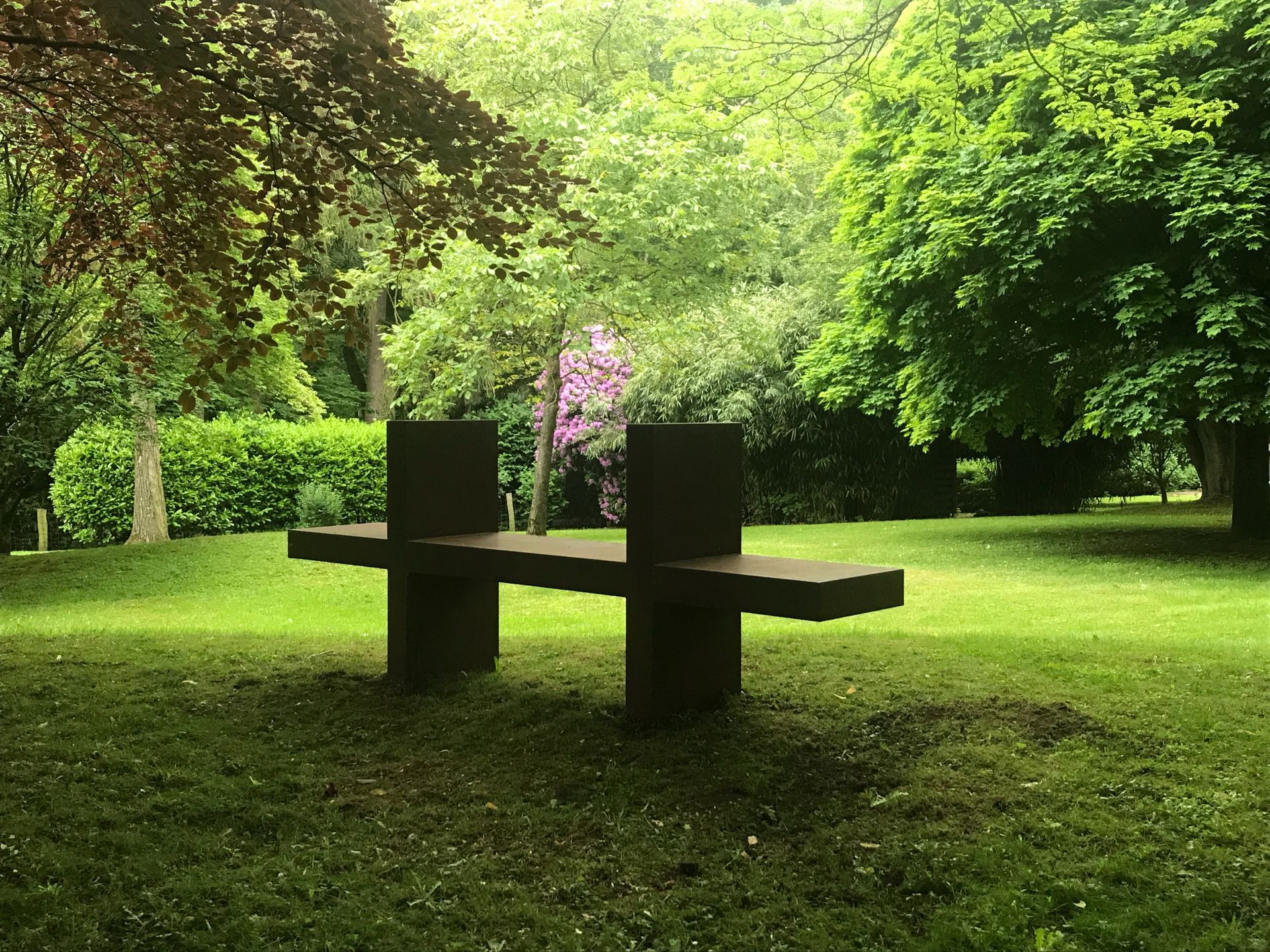Die weitsichtige Besonnenheit der Skulpturen
Textfragment: Thomas Hirsch
Ein Merkmal der Skulpturen von Ernst Hesse ist ihre Selbstverständlichkeit, ihre introvertierte Präsenz, die sich als Modus der Kommunikation dem Betrachter gegenüber erweist. Das liegt mit am Primären der Formensprache, die aus der Geometrie und der Stereometrie abgeleitet und mitsamt der Kombinatorik ihrer Formen stimulierend ist. Überhaupt, in allen Phasen dieses vielschichtigen – von Zeichnungen, Videos und Fotoarbeiten gleichberechtigt flankierten – plastischen Werkes findet eine ordnende Klärung der Einzelformen statt. Zum Dialogischen tragen außerdem Referenzen an die Wirklichkeit bei, welche als Formerscheinung oder als Abguss in Skulpturen übersetzt sind, und indem Orte skulptural definiert werden. Hesse befragt urbane, kulturelle und soziale Verhältnisse, und wenn man nun die Skulpturen, die er in Stahl und Eisen, Bronze, Gips und in Holz oder zuletzt Draht geschaffen hat, Tendenzen der Konstruktiven Kunst zurechnen kann,
dann vor allem in ihrer formalen Klarheit und der gesellschaftlichen Bewusstheit.
Hesse hat zudem unterschiedliche Gegenstände aus unserer Alltagswelt zu plastischen Ensembles zusammengestellt. Er zieht lebensnotwendige Ressourcen
hinzu und verweist auf die Rolle der Natur, und zwar in Ländern, die außerhalb der eurozentrischen Perspektive liegen und die er auf eigene Initiative, teils in Zusammenarbeit mit dem Goethe Institut, besucht hat. Er erinnert in seinen Werk- und Diskussionsbeiträgen an die Einzigartigkeit der Schöpfung und die überlieferten Traditionen an den uns fernen Orten. Er befragt Heimat und Identität und schlägt eine Brücke zwischen den Kulturen. Dazu konzentriert er seine Beobachtungen und Erfahrungen beispielsweise in einer meterhohen Stahlskulptur, die von den japanischen oder hebräischen Schriftzeichen abgeleitet und als inhaltliche Aussage begreifbar ist oder in fotografischen Aufnahmen dicht wuchernder Vegetation und, dokumentierend, der gestreuten Muster aus Reismehl (Kolam) vor den Hauseingängen in Südindien. Derartige Verweise hat Ernst Hesse in einer umfassenden Monographie zusammengetragen, die 2002 im Kölner Salon Verlag erschienen ist. Schon ihr Titel „Räume öffnen“ äußert die Hoffnung, festgefügte Vorstellungen durch Gesprächsbereitschaft und Neugierde gegenüber den Anderen aufzubrechen …
The far-sighted common sense of the sculptures
One thing that stands out about Ernst Hesse’s sculptures is how obvious they seem, their introverted presence that turns out to be a means of communication
vis-à-vis the observer. This can be attributed primarily to the formal idiom chosen, which is derived from geometry and stereometry and together with the combinations of shapes is stimulating. Indeed, in all phases of this complex sculptural oeuvre (and all of them have been accompanied by equally important drawings, videos, and photo works) the individual shapes are clarified and simultaneously ordered. References to reality that are translated into sculptures as a formal manifestation or as casts, and by places being sculpturally defined both broach dialog with the viewer. Hesse questions urban, cultural and social relationships,
and if the works that he fashions in steel and iron, bronze, plaster and in wood or more recently in wire can be ascribed to aspects of Constructivist art then above
all thanks to their formal clarity and social awareness.
Moreover, Hesse has assembled various items from our everyday world to create sculptural ensembles.
He draws on vitally essential resources and references the role of nature – specifically in countries that lie beyond any Eurocentric perspective and which he visits
on his own initiative, sometimes in collaboration with Goethe-Institut. In his oeuvre and his contributions to discussions, he reminds us of the uniqueness of creation and the traditions in places that are so remote for us. He questions notions of home and identity and builds a bridge between cultures. He does this, for example,
by concentrating his observations and experiences in a steel sculpture several meters high that is informed by Japanese or Hebrew characters and can be read
as a clear statement, or in photographic images of densely rampant vegetation and documenting the scattered patterns made with rice flour (kolam) on the ground outside the entrances of homes in Southern India.Ernst Hesse collected references like this in a comprehensive monograph that was published 2002 by Cologne’s Salon Verlag. The title “Räume öffnen” (Opening Up Spaces) itself expresses the hope that rigid concepts can be undermined by a willingness to talk and curiosity towards those with whom one is communicating. Translation: Jeremy Gaines































